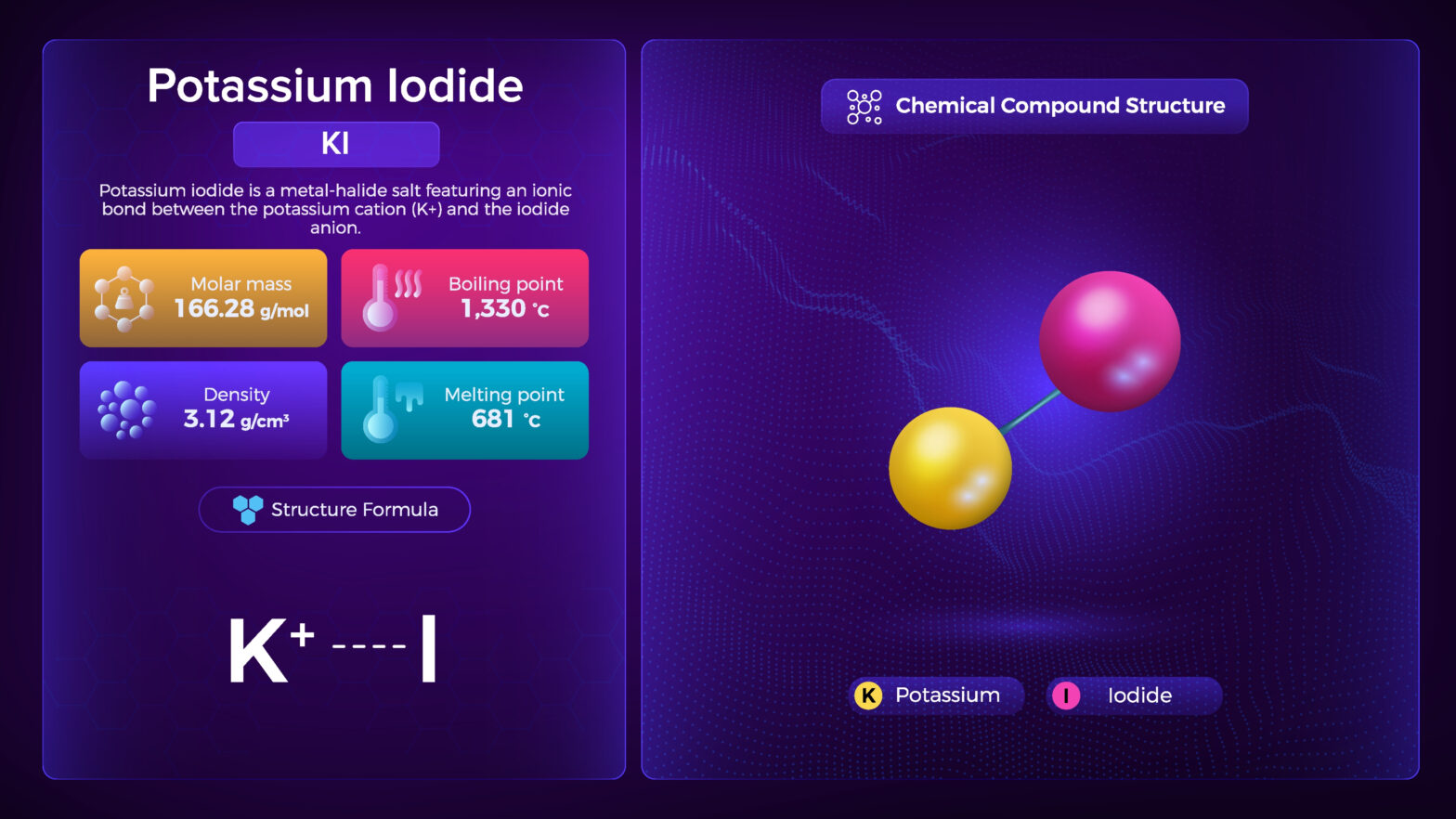INTRODUCTION
Potassium iodide is an inorganic chemical compound which is denoted by the chemical formula KI. It is a metal-halide salt featuring an ionic bond between the potassium cation (K+) and the iodide anion (I–). It is colourless to white, it appears as powder or white granules. It has a highly bitter, saline taste.
It is an essential iodide source in several organic synthesis reactions. It has a variety of applications in coatings, animal feed, life sciences, pigments, polymer additives, and process chemicals. Having reactive properties, iodide can be a part of many oxidising reactions, as well as create stable ionic complexes with carbon. Iodine ions play a significant role in regulating human growth hormones.
Manufacture
Commercially it is made by mixing potassium hydroxide with iodine.
| CAS no. | 7681-11-0 |
| EINECS no. | 213-659-4 |
| Molecular formula | IK |
| Molecular weight | 166 |
| Structure | KI |
Applications
KI is a versatile compound that is used in a variety of industries
| Animal Nutrition | To address the Iodine deficiency to fulfil the nutrition needs of the Animals. Helps optimize nutrition, improve gut health, support immune function, improve the absorption of nutrients that help in extending the shelf life of feed, and reducing harmful pathogens in the feed and water animals consume. |
| Electronics | It is used as a polarizing agent in LCD and LED screens manufacturing. |
| Expectorant | It is used as an expectorant for those who suffer from chronic breathing disorders like asthma, bronchitis and emphysema. |
| Human Nutrition | Iodine is an essential element for human growth and development. Potassium Iodide is used in the manufacturing of dietary supplements for children and adults. |
| Lab Chemicals | Potassium Iodide is used in the laboratory as reagents, extraction agents and additives for various chemistry and biochemistry analysis. |
| Oil and Gas | It is used for corrosion inhibition and leak detection in upstream oil and gas production. |
| Polymer | Potassium Iodide is used as heat stabilizing agents in the manufacture of Nylon tire cord. Its main use is the manufacture of tires, where the heat resistance of the polymer is essential. |
SPECIFICATIONS
| Test | Unit | Specification |
|---|---|---|
| Appearance | – | White crystalline powder |
| Odour | – | Odourless |
| Assay (on dry basis) | % | Min 99.0 |
STORAGE
Store at ambient conditions in closed containers away from heat and moisture.
PACKING
25 kg Fiber / HDPE Drum.
CERTIFICATION
FAMI-QS, Halal & Kosher.
REACH Status
KI offered by ExSyn is registered under EU REACH regulations.
ExSyn offers KI on commercial scales and welcomes enquiries. No matter the quantity you need, our exceptional quality and service will make ExSyn your supplier of choice! If you need any additional information or SDS, please contact us.
Iodine is anon-metallic, dark-grey/purple-black, lustrous, solid element. It is the heaviest and the rarest of stable halogens that can be found on the crust of earth.About fifty percent of all iodine produced and manufactured worldwide is used to form Organoiodine compounds. Iodine is an important element for many health-sustaining processes and essential for human thyroid health.
The product, acronymed Oct-NBE, is an organic compound with a cyclic ring system and a 8-membered hydrophobic chain. The structure renders the chemical special properties leading to its applications in diverse fields.
Nicotine is a hygroscopic, colorless to slight yellow, oily liquid, that is readily soluble in alcohol, ether or light petroleum. It is widely used recreationally as a stimulant and anxiolytic.
The product, acronymed ETD, is an organic compound with a fused bicyclic ring system and an ethylidene group. The structure renders the chemical special properties leading to its applications in diverse fields.
Sodium perchlorate monohydrate is the inorganic compound with the chemical formula NaClO4•H2O. It is the common existence form of sodium perchlorate, which can gradually absorb water in the air to form the monohydrate. Sodium perchlorate monohydrate is white rhombic crystal which is highly soluble in water and in alcohol. Its capacity to undergo redox reactions, liberating oxygen atoms, has been harnessed in the preparation of specialty chemicals, including pharmaceutical intermediates and fine chemicals.
Triphenylphosphine is a common organophosphorus compound that is frequently abbreviated as PPh3 or Ph3P. It is widely used in organic and organometallic compound synthesis because it is an effective reducing agent as well as a neutral ligand. At room temperature, PPh3 crystals are relatively air-stable and colourless.
Potassium chlorate holds significant importance across various industries due to its diverse applications. This white crystalline compound has been utilized for centuries as an essential ingredient in the production of matches, fireworks, and explosives, owing to its ability to release oxygen upon decomposition.
Podophyllotoxin is a non-alkaloid toxin lignan extracted from the roots and rhizomes of Podophyllum species. It is an organic heterotetracyclic compound that has a Furonaphthodioxole skeleton bearing a 3,4,5-trimethoxyphenyl substituent.
Octadecylphosphonic acid (ODPA), a versatile chemical compound, serves as a surfactant and dispersant in applications spanning coatings, lubricants, and corrosion inhibition. With its hydrophobic octadecyl chain linked to a phosphonic acid group, it excels in surface modification, boosting adhesion in metal surfaces.
